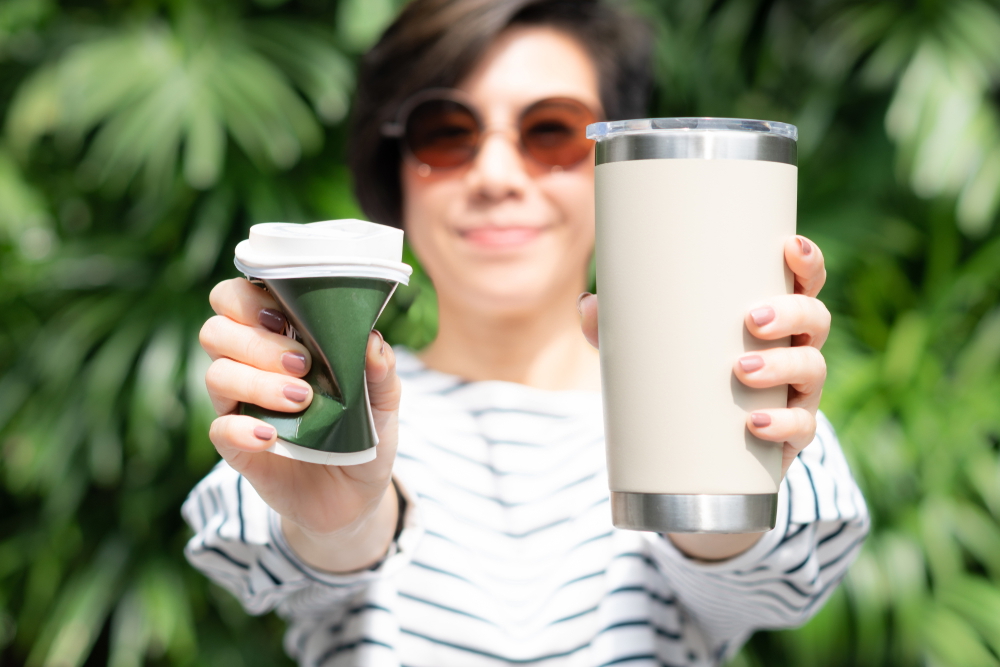Paper Cups vs Other Materials in Environmental Impact
By Morten Numrich · 21. June 2024
When considering the environmental impact of your morning coffee’s container, it’s crucial to compare paper cups vs other materials.
This article examines the ecological footprint of paper cups, from their complex recycling challenges to their contribution to waste and pollution.
How do they stack up against plastics, or more sustainable alternatives like glass, ceramic, and metal cups?
We’ll delve into the lifecycle analysis of each, revealing the environmental costs right from production to disposal.
Paper Cups in the Spotlight
 woman hand holding coffee paper cups
woman hand holding coffee paper cups
In the realm of disposable cups, paper ones are ubiquitous, lining the shelves of coffee shops and vending machines alike.
Yet, their omnipresence belies a pressing issue: the daunting task of recycling these vessels.
Despite their paper construction, these single-use icons are far from simple.
Composition and Use
Made from wood pulp fibres, paper cups range from single-wall variants that serve as perfect handheld carriers for hot drinks to double-wall designs that offer extra insulation.
To safeguard against sogginess, these cups are lined with a thin sheath of plastic, most commonly PLA or PE, rendering them waterproof but complicating their end-of-life journey.
In this context, paper and plastic cups refer to the combination of materials used in their construction.
Recycling Challenges
The Achilles’ heel of the paper cup lies in its very design: the plastic lining that ensures your coffee stays within its confines equally ensures that recycling becomes a Herculean task.
This unassuming layer of plastic not only impedes the recycling process but, when relegated to the shadowy depths of a landfill, contributes to the release of methane, a greenhouse gas with a warming potential far exceeding that of CO2. ☹️
Therefore, each unrecycled cup contributes to the fabric of environmental harm, created by the energy-consuming cycle of raw material extraction, production, and disposal.
A Comparative Look at Plastic Cups
Plastic cups, often hailed for their durability and cost-effectiveness, enter the environmental arena with their own set of complex considerations.
A single plastic cup, moulded from polymers such as polypropylene (PP) or polyethylene terephthalate (PET), stands as a testament to human ingenuity while simultaneously embodying the paradox of plastic — a material both celebrated for its utility and scorned for its environmental toll.
Production and Environmental Footprint
The impact of plastic cups, including styrofoam cups, starts at their creation phase, which involves significant carbon emissions.
Crafting these vessels involves not only a significant energy input but also the emission of roughly 33 grams of CO2 for each polystyrene foam cup produced, contributing to their carbon footprint. 🏭
Further, the production stage incorporates additives to enhance durability, prolonging the cup’s lifespan but delaying its decomposition.
Moreover, the materials employed, such as benzene and styrene, are not without consequence, posing potential risks to human health.
Disposal and Longevity
The disposal phase of plastic cups is marked by a tale of prolonged existence and regret.
With a decomposition timeline stretching up to 450 years, these vessels transition from containers of convenience to persistent pollutants.
As they slowly fragment into micro and nanoplastics, they become unwelcome guests in ecosystems, dispersing harmful chemicals and posing risks to wildlife and habitats alike. 🌊🐢
The problem is exacerbated as polyethylene-lined paper cups, despite decomposing faster, still add to landfill waste and ocean pollution due to their complex plastic lining.
The sheer volume of plastics, including those from cups, that degrade into nearly invisible but environmentally hazardous microplastics is staggering, underscoring the urgent need for responsible disposal practices.
Reusable Cup Alternatives: Glass, Ceramic, and Metal
 woman holding reusable takeaway coffee cup and paper cup
woman holding reusable takeaway coffee cup and paper cup
Defying the trend of single-use cups, reusable paper cups made of glass, ceramic, metal, and reusable plastic offer a chance to disrupt the cycle of disposable waste.
Embracing the use of these materials, including reusable plastic cups, not only mitigates the demand for new plastic manufacturing but also aligns with a more sustainable, environmentally conscious trajectory. ♻️
The repeated use of these durable alternatives, made from recycled materials, whether in office corners or at home, steers us towards a greener lifestyle.
Glass and Ceramic Cups
The appeal of glass and ceramic cups stems from their straightforwardness and sustainability.
While their initial production may demand substantial energy, particularly in the case of glass, their real strength shines in their longevity and minimal impact when discarded.
Ceramic, an amalgam of heated clay, quietly returns to the earth with little fanfare.
Glass, on the other hand, offers the remarkable ability to be recycled indefinitely without loss of quality, breaking down without releasing synthetic chemicals into the environment.
Metal Cups
Metal cups, known for their shiny surfaces and robust nature, join the sustainability debate carrying a significant environmental footprint during production.
However, their true value unfolds with each reuse, proving particularly cost-effective in settings such as stadiums or events, where their durability can be leveraged over and over. 🏟️
Yet, the story of metal cups is not without gaps, particularly when it comes to their recycling process, a detail that requires illumination for a full environmental accounting.
The Lifecycle Analysis of Cup Materials
A lifecycle analysis reveals a clear contrast between single-use and reusable cups.
While the former may offer convenience, the latter provides a path to environmental respite, showcasing a reduced impact across their entire lifespan.
This comprehensive approach considers every stage of a cup’s existence, including:
- Raw material extraction
- Manufacturing and production
- Distribution and transportation
- Use and consumption
- Disposal and waste management
By considering these factors, we can paint a vivid picture of the environmental stakes at play and make more informed choices about our cup usage.
Material Extraction and Energy Source
The early stages of a cup’s life, including raw material extraction and processing, lay the groundwork for its environmental impact.
Glass cup production, for instance, although energy-intensive, can be somewhat redeemed through recycling, which slashes energy consumption significantly.
On the other hand, the energy requirements for making disposable cups, encompassing both manufacturing and transportation, significantly contribute to environmental harm.
These findings underscore the importance of life cycle assessments in weighing the environmental implications of material choices and energy sources. 💡🌱
Total Impact on Environment
Every stage of a cup’s journey, from creation to consumption to conclusion, bears environmental consequences.
Reusable cups distinguish themselves by eschewing the need for repeated manufacturing, thereby conserving energy and water resources.
Their adoption can significantly reduce greenhouse gas emissions, curtailing the exhaustive cycle of production, transportation, and disposal that plagues their single-use counterparts.
Despite these benefits, it is crucial to acknowledge the lingering shadow of disposable cups, which continue to consume energy and degrade the environment from production to landfill, with plastic cups in particular contributing to alarming levels of CO2 emissions.
Glass, while highly recyclable, brings into question the energy efficiency of its transportation, hinting at the delicate balance and trade-offs inherent in environmental stewardship.
Summary
As the last drops of coffee are savoured and the final thoughts are poured, it becomes evident that the choice of cup material holds profound environmental implications.
From the recyclability of paper and plastic to the enduring nature of glass, ceramic, and metal, each option presents its own narrative of impact and opportunity.
Embracing reusable alternatives stands as a beacon of sustainability, guiding us towards a future where convenience and environmental consciousness can coexist harmoniously. ☕🌿
Frequently Asked Questions
Why are paper cups often not recycled?
Paper cups are often not recycled because their plastic lining makes it difficult and sometimes not economically feasible to separate the plastic from the paper using current recycling systems. This challenge hinders the recycling process. ♻️
What is the environmental impact of plastic cups?
The environmental impact of plastic cups is significant, as they require large amounts of energy to produce, contribute to pollution through microplastic formation, and can take up to 450 years to degrade.
Are glass and ceramic cups better for the environment than disposable ones?
Yes, glass and ceramic cups are better for the environment than disposable ones because they can be reused multiple times, reducing the need for continuous production of disposable cups. Glass can also be recycled indefinitely without quality loss, and ceramic cups have minimal impact when disposed of.
How many times do metal cups need to be used to be environmentally viable?
Metal cups need to be reused multiple times to offset their higher production impact. On average, they are used about 15 times per year, making them a financially and environmentally viable option.
What does a lifecycle analysis reveal about the environmental impact of cups?
Reusable cups have a lower environmental impact than disposable cups throughout their entire lifecycle, including savings in energy and water resources and reduced greenhouse gas emissions. This conclusion is based on a lifecycle analysis. 🌎

